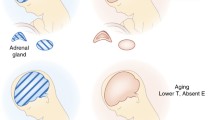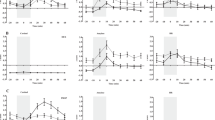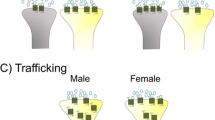Abstract
In this report, the authors propose that underlying sex differences in the biobehavioral response to stress may contribute to the variance in prevalence of some psychiatric disorders based on sex. The authors begin with a discussion of stress physiology and review a new theory on sex differences in stress responses (ie, the “tend-and-befriend” response), which may provide a recent framework for considering sex differences in the manifestation of some psychiatric illnesses. The authors then move to a discussion of major depression and attention deficit hyperactivity disorder as examples of how sex differences in stress responses may influence the behavioral symptoms of psychiatric disorders that are more often diagnosed in one sex compared with another. The authors conclude with a brief discussion of the implications of this new perspective on treatment approaches and encourage further inquiry into the importance of sex-based differences in the behavioral manifestation of some psychiatric illnesses.
Similar content being viewed by others
References and Recommended Reading
Institute of Medicine: Exploring the Biological Contributions to Human Health: Does Sex Matter? Washington DC: National Academy Press; 2001. Important report by panel of a vast array of experts in the biomedical field who were asked to review and evaluate the current state of knowledge about sex differences in health and illness. This report indicates that 1) sex matters and is an important variable to consider in biomedical and health-related research; and 2) the study of sex differences is evolving into a mature science. The panel encourages interdisciplinary research on sex differences to enhance understanding of sex differences in health and illness, which may shed light on understanding sex-based differences in the prevalence of psychiatric illness.
American Psychiatric Association: Diagnostic and Statistical Manuel of Mental Disorders, edn 4. Washington DC: American Psychiatric Association; 1994.
Dantzer R, Aubert A, Bluthe R, et al.: Mechanisms of the behavioural effects of cytokines. Adv Exp Med Biol 1999, 461:83–106.
McEwen BS: Protective and damaging effects of stress mediators. N Engl J Med 1998, 338:171–179.
Sapolsky RM: Why Zebras Don’t Get Ulcers: A Guide to Stress, Stress-Related Disease, and Coping. New York: Freeman and Company; 1994.
Taylor SE, Klein LC, Lewis BP, et al.: Female responses to stress: Tend-and-befriend, not fight-or-flight. Psychol Rev 2000, 107:411–429. The basis of the current report, this paper outlines new "tend-andbefriend" theory of how women respond to stress, which differs from the traditional "fight-or-flight" stress response.
Baum A, Grunberg NE, Singer JE: The use of psychological and neuroendocrinological measurements in the study of stress. Health Psychol 1982, 1:217–236.
Cannon WB: The Wisdom of the Body. New York: Norton; 1932.
Stratakis CA, Chrousos GP: Neuroendocrinology and pathophysiology of the stress system. In In Stress: Basic Mechanisms and Clinical Implications. Edited by Chrousos GP, McCarty R, Pacák K, et al. New York: The New York Academy of Sciences; 1995:1–18.
de Wied D, Diamant M, Fodor M: Central nervous effects of neurohypophyseal hormones and related peptides. Neuroendocrinology 1993, 14:251–302.
Gibbs DM: Vasopressin and oxytocin. Hypothalamic modulators of the stress response: a review. Psychoneuroendocrinology 1986, 11:131–140.
Russell JA: Neuroendocrinology with feeling. J Neuroendocrinol 2002, 14:1–3.
Chrousos GP: The hypothalamic-pituitary-adrenal axis and immune-mediated inflammation. N Engl J Med 1995, 332:1351–1362.
Cohen S, Tyrell DA, Smith AP: Psychological stress and susceptibility to the common cold. N Engl J Med 1991, 325:606–612.
Watkins LR, Nguyen KT, Lee JE, Maier SF: Dynamic regulation of proinflammatory cytokines. Adv Exp Med Biol 1999, 461:153–178.
Dobbin JP, Harth M, McCain GA, et al.: Cytokine production and lymphocyte transformation during stress. Brain Behav Immun 1991, 5:339–348.
Liao J, Keiser J, Scales WE, et al.: Role of corticosterone in TNF and IL-6 produciton in isolated perfused rat liver. Am J Physiol 1995, 268:R699-R706.
Gabay C, Kushner I: Acute-phase proteins and other systemic responses to inflammation. N Engl J Med 1999, 340:448–454.
Maes M, Meltzer HY, Bosmans E, et al.: Increased plasma concentrations of interleukin-6, soluble interleukin-6, soluble interleukin-2, and transferrin receptor in major depression. J Affect Disord 1995, 34:301–309.
Heffelfinger AK, Newcomer JW: Glucocorticoid effects on memory function over the human life span. Dev Psychopathol 2001, 13:491–513.
Sapolsky RM: Why stress is bad for your brain. Science 1996, 273:749–750.
Sapolsky RM: Glucocorticoids and hippocampal atrophy in neuropsychiatric disorders. Arch Gen Psychiatry 2000, 57:925–935. Excellent review of the brain damaging effects of stress and the role that stress hormones may play in the development of psychiatric disorders.
Sapolsky RM: The possibility of neurotoxicity in the hippocampus in major depression: a primer on neuron death. Biol Psychiatry 2000, 48:755–765.
Sapolsky RM: Atrophy of the hippocampus in posttraumatic stress disorder: how and when? Hippocampus 2001, 11:90–91.
Geracioti TD, Baker DG, Ekhator NN, et al.: CSF norepinephrine concentrations in posttraumatic stress disorder. Am J Psychiatry 2001, 158:1227–1230.
Nutt DJ: Neurobiological mechanisms in generalized anxiety disorder. J Clin Psychiatry 2001, 62(suppl):22–27.
Ballenger JC: Overview of different pharmacotherapies for attaining remission in generalized anxiety disorder. J Clin Psychiatry 2001, 62(suppl):11–19.
Cannon JG, St. Pierre B: Gender differences in host defense mechanisms. J Psychiatr Res 1997, 31:99–113.
Gray J: Sex differences in emotional behavior in mammals including man: endocrine bases. Acta Psychol 1971, 35:29–46.
Greeno CG, Wing RR: Stress-induced eating. Psychol Bull 1994, 115:444–464.
Grunberg NE, Straub RO: The role of gender and taste class in the effects of stress on eating. Health Psychol 1992, 11:97–100.
Jezova D, Jurankova E, Mosnarova A, et al.: Neuroendocrine response during stress with relation to gender differences. Acta Neurobiol Exp 1996, 56:779–785.
Kant GJ, Lenox RH, Bunnell BN, et al.: Comparison of the stress response in male and female rats: pituitary cyclic AMP and plasma prolactin, growth hormone and corticosterone. Psychoneuroendocrinology 1983, 8:421–428.
Klein LC, Popke EJ, Grunberg NE: Sex differences in effects of predictable and unpredictable footshock on fentanyl selfadministration in rats. Exp Clin Psychopharmacol 1997, 5:99–106.
Carter CS, Altemus M: Integrative functions of lactational hormones in social behavior and stress management. Ann N Y Acad Sci 1997, 807:164–174.
Cho MM, DeVries AC, Williams JR, Carter CS: The effects of oxytocin and vasopressin on partner preferences in male and female prairie voles (Microtus ochrogaster). Behav Neurosci 1999, 113:1071–1079.
McCarthy MM: Estrogen modulation of oxytocin and its relation to behavior. In In Oxytocin: Cellular and Molecular Approaches in Medicine and Research. Edited by Ivell R, Russell J. New York: Plenum Press; 1995:235–242.
McCarthy MM, Altemus M: Central nervous system actions of oxytocin and modulation of behavior in humans. Mol Med Today 1997, 3:269–275.
Insel TR, Winslow JT, Wang Z, Young LJ: Oxytocin, vasopressin, and the neuroendocrine basis of pair bond formation. In In Vasopressin and Oxytocin: Molecular, Cellular, and Clinical Advances. Edited by Zingg HH, Bourque CW, Bichet DG. New York: Plenum Press; 1998:215–224.
Uvnas-Moberg K: Neuroendocrinology of the mother-child interaction. Trends Endocrinol Metab 1996, 7:126–131.
Young LJ, Lim MM, Gingrich B, Insel TR: Cellular mechanisms of social attachment. Horm Behav 2001, 40:133–138. Outstanding review of the neuroendocrine underpinnings of social attachment and social behavior. A rapidly developing field of scientific inquiry, this research provides support for the role of oxytocin and vasopressin in mammalian behavior, including the proposal that men and women may differ in their response to stress.
Uvnas-Moberg K: Oxytocin linked antistress effects: the relaxation and growth response. Acta Psychol Scand 1997, 640(suppl):38–42.
Light KC, Smith TE, Johns JM, et al.: Oxytocin responsivity in mothers of infants: a preliminary study of relationships with blood pressure during laboratory stress and normal ambulatory activity. Health Psychol 2000, 19:560–567.
Altemus M, Redwine LS, Leong YM, et al.: Responses to laboratory psychosocial stress in postpartum women. Psychosom Med 2001, 63:814–821.
Mezzacappa ES, Katlin ES: Breast-feeding is associated with reduced perceived stress and negative mood in mothers. Health Psychol 2002, 21:187–193.
Turner RA, Altemus M, Enos T, et al.: Preliminary research on plasma oxytocin in healthy, normal cycling women: investigating emotion and interpersonal distress. Psychiatry 1999, 62:97–113.
Anderberg UM, Uvnas-Moberg K: Plasma oxytocin levels in female fibromyalgia syndrome patients. Zeitschrift fur Rheumatologie 2000, 59:373–379.
Winslow JT, Hearn EF, Ferguson J, et al.: Infant vocalization, adult aggression, and fear behavior of an oxytocin null mutant mouse. Horm Behav 2000, 37:145–155.
Brett M, Baxendale S: Motherhood and memory: a review. Psychoneuroendocrinology 2001, 26:339–362.
Ferguson JN, Young LJ, Insel TR: The neuroendocrine basis of social recognition. Front Neuroendocrinol 2002, 23:200–224.
Hatton GI: Emerging concepts of structure-function dynamics in adult brain: the hypothalamo-neurohypophysial system. Progress Neurobiol 1990, 34:437–504.
Gash DM, Boer GJ: Vasopressin, Principles and Properties. New York: Plenum; 1987.
Swaab DF, Hofman MA, Lucassen PJ, et al.: Functional neuroanatomy and neuropathology of the human hypothalamus. Anat Embryol 1993, 187:317–330.
Engelmann M, Ebner K, Landgraf R, et al.: Emotional stress triggers intrahypothalamic but not peripheral release of oxytocin in male rats. J Neuroendocrinol 1999, 11:867–872.
Engelmann M, Wotjak CT, Ebner K, Landgraf R: Behavioral impact of intraseptally released vasopressin and oxytocin in rats. Exp Physiol 2000, 85S:125S-130S.
Legros JJ: Inhibitory effect of oxytocin on corticotrope function in humans: are vasopressin and oxytocin ying-yang neurohormones?. Psychoneuroendocrinology 2001, 26:649–655.
Crofton JT, Ratliff DL, Brooks DP, Share L: The metabolic clearance rate of and pressor responses to vasopressin in male and female rats. Endocrinology 1986, 118:1777–1781.
Crofton JT, Share L, Brooks DP: Pressor responsiveness to and secretion of vasopressin during the estrous cycle. Am J Physiol 1988, 255:R1041-R1048.
Rhodes ME, Rubin RT: Functional sex differences (sexual diergism) of central nervous system cholinergic systems, vasopressin, and hypothalamic-pituitary-adrenal axis activity in mammals: a selective review. Brain Res Rev 1999, 30:135–152.
Neumann ID, Torner L, Wigger A: Brain oxytocin: differential inhibition of neuroendocrine stress responses and anxietyrelated behaviour in virgin, pregnant and lactating rats. Neuroscience 2000, 95:567–575.
Neumann ID, Wigger A, Torner L, et al.: Brain oxytocin inhibits basal and stress-induced activity of the hypothalamo-pituitary-adrenal axis in male and female rats: Partial action within the paraventricular nucleus. J Neuroendocrinol 2000, 12:235–243.
Windle RJ, Shanks N, Lightman SL, Ingram CD: Central oxytocin administration reduces stress-induced corticosterone release and anxiety behavior in rats. Endocrinology 1997, 138:2829–2834.
Griebel G, Simiand J, Serradeil-Le Gal C, et al.: Anxiolytic- and antidepressant-like effects of the non-peptide vasopressin V1b receptor antagonist, SSR149415, suggest an innovative approach for the treatment of stress-related disorders. Proc Natl Acad Sci U S A 2002, 99:6370–6375. This paper outlines exciting advances in psychopharmacologic treatment approaches to psychiatric illness that target the poster pituitary hormone system.
Uvnas-Moberg K, Bjokstrand E, Hillegaart V, Ahlenius S: Oxytocin as a possible mediator of SSRI-induced antidepressant effects. Psychopharmacology 1999, 142:95–101.
Klein LC, Popke EJ, Grunberg NE: Sex differences in effects of opioid blockade on stress-induced freezing behavior. Pharmacol Biochem Behav 1998, 61:413–417.
Gray JA, Lalljee B: Sex differences in emotional behavior in the rat: correlation between open field defecation and active avoidance. Animal Behav 1974, 22:856–861.
Maren S, De Oca B, Fanselow MS: Sex differences in hippocampal long-term potentiation (LTP) and Pavlovian fear conditioning in rats: Positive correlation between LTP and contextual learning. Brain Res 1994, 661:25–34.
Weich S, Sloggett A, Lewis G: Social roles and the gender difference in rates of the common mental disorders in Britain: a 7-year, population-based cohort study. Psychol Med 2001, 31:1055–1064.
Blair-West GW, Mellsop GW: Major depression: does a genderbased down-rating of suicide risk challenge its diagnostic validity? Aust N Z J Psychiatry 2001, 35:322–328. Interesting discussion and argument for gender-based diagnosing of major depression. Authors suggest sex differences in the manifestation of major depression that might be captured through broader diagnostic criteria.
Maciejewski PK, Prigerson HG, Mazure CM: Sex differences in event-related risk for major depression. Psychol Med 2001, 31:593–604.
Sherrill JT, Anderson B, Frank E, et al.: Is life stress more likely to provoke depressive episodes in women than in men?. Depress Anxiety 1997, 6:95–105.
Taylor SE, Dickerson SS, Klein LC: Toward a biology of social support. In In Handbook of Positive Psychology. Edited by Snyder CR, Lopez SJ. New York: Oxford University Press; 2002:556–569.
Centers for Disease Control and Prevention: Epidemiologic Research on ADHD: What We Know and What We Need to Learn. Presented at Attention-Deficit/Hyperactivity Disorder: A Public Health Perspective Conference; Atlanta, GA. September 23, 1999;
Zito J, dos Reis S, Gardner J: Trends in the prescribing of psychotropic medications to preschoolers. JAMA 2000, 283:1025–1030.
Brandon CL, Marinelli M, Baker LK, White FJ: Enhanced reactivity and vulnerability to cocaine following methylphenidate treatment in adolescent rats. Neuropsychopharmacology 2001, 25:651–661.
Smucker W, Hedayat M: Evaluation and treatment of ADHD. Am Fam Physician 2001, 64:817–829.
Arcia E, Connors CK: Gender Differences in ADHD? J Dev Behav Pediatr 1998, 19:77–83.
Gershon J: A meta-analytic review of gender differences in ADHD. J Attention Disord 2002, 5:143–154. Excellent review of gender differences in prevalence of ADHD. Findings suggest that ADHD girls have lower ratings on hyperactivity, inattention, impulsivity, and externalizing problems compared with ADHD boys. Paper adds to growing body of literature suggesting that changes are needed in assessing sex differences in prevalence of some psychiatric disorders.
Berry CA, Shaywitz SE, Shaywitz BA: Girls with attention deficit disorder: s silent majority? A report on behavioral and cognitive characteristics. Pediatrics 1985, 76:801–809.
Swaab DF, Fliers E, Hoogendijk WJG, et al.: Interaction of prefrontal cortical and hypothalamic systems in the pathogenesis of depression. Progr Brain Res 2000, 126:369–396. Comprehensive and thoughtful review of role that stress-activated pathways and hormones play in the development of major depression. Also addresses potential sex differences in these effects.
Author information
Authors and Affiliations
Rights and permissions
About this article
Cite this article
Klein, L.C., Corwin, E.J. Seeing the unexpected: How sex differences in stress responses may provide a new perspective on the manifestation of psychiatric disorders. Curr Psychiatry Rep 4, 441–448 (2002). https://doi.org/10.1007/s11920-002-0072-z
Issue Date:
DOI: https://doi.org/10.1007/s11920-002-0072-z




